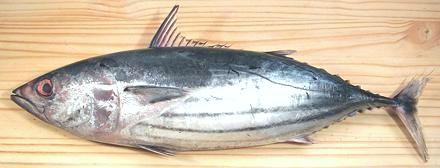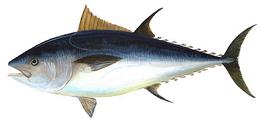 [family Scombridae (Mackerels)]
[family Scombridae (Mackerels)]
Tuna include the largest members of the Mackerel family. Unlike those called "Mackerel", tunas have deep flattened bodies. Most have scales only in a few places but that's enough to be kosher. Bluefin Tuna (all varieties) is to be avoided as all Bluefins are critically endangered. Yellowfin, Bonito, Tongal, Skipjack, Bigeye and Albacore are acceptable for eating.
More on Varieties of Fish
(very large page).
 [Island Skipjack, Black Skipjack, Kawakawa (Hawaii), Tongol Tuna,
Little Tuna, Mackerel Tuna (English); Tulingan (Philippine); Tongkol
(Malay); Euthynnus affinis]
[Island Skipjack, Black Skipjack, Kawakawa (Hawaii), Tongol Tuna,
Little Tuna, Mackerel Tuna (English); Tulingan (Philippine); Tongkol
(Malay); Euthynnus affinis]
This small Indo Pacific tuna is found from the east coast of Africa
to Hawaii and is an important commercial fish. Unlike the Skipjack proper
(Katsuwonus pelamis) it stays fairly close to shore. It can grow to
39 inches and over 30 pounds, but the photo specimen was 19-1/2 inches and
3-1/4 pounds, about typical for Southern California markets. This fish is
not currently considered endangered, IUCN Red List status is
NE (Not Evaluated).
Details and Cooking.
 [Katsuo (sushi); Katsuwonus pelamis]
[Katsuo (sushi); Katsuwonus pelamis]
These small tuna can grow to over 43 inches and over 76 pounds, but the photo specimen was 18-1/2 inches and 3 pounds 13 ounces, about average in Southern California markets. Skipjack is found worldwide in tropical and warm-temperate seas but not in the Eastern Mediterranean or Black Sea.
Commercially Skipjack is sold fresh, frozen and canned, with a small
amount sold smoked and dried. This fish is not considered endangered. IUCN
Red List status NE (Not Evaluated).
Details and Cooking.
 [Kuromaguro, Hon Maguro, Toro (Japan); Thunnus thynnus
(Northern / Atlantic) | Thunnus maccoyii (Southern)
| Thunnus orientalis (Pacific)]
[Kuromaguro, Hon Maguro, Toro (Japan); Thunnus thynnus
(Northern / Atlantic) | Thunnus maccoyii (Southern)
| Thunnus orientalis (Pacific)]
Bluefin Tuna is the most prestigious sushi / sashimi fish in Japan, and the Japanese are eating them to extinction. Bluefins are listed as Critically Endangered in all conservation lists, but the Japanese simply don't care - the scarcer they are the more they'll pay, because the higher the cost of a fish the better it tastes to the Japanese. It has been reported that a single large Atlantic Bluefin can now fetch as much as 2010 US $100,000 in the Japanese fish markets. Do not eat this fish, and strongly discourage others from eating it.
Note that "farmed" is not an acceptable alternative, in fact for
Atlantic Bluefin (the most threatened) farming, which depends on wild
fish captured before reproductive maturity, is a major cause of depletion.
For Pacific and Southern Bluefin, there has recently been some success in
captive breeding, but this is still in early experimental stages and is in
no way able to impact the market at this time (2010).
Drawing from U.S. National Oceanic and Atmospheric
Administration = public domain.